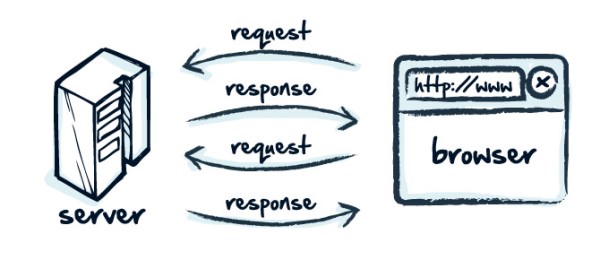You are viewing the article What is http and https protocol? What’s different? Things to know to use the Internet more safely at Tnhelearning.edu.vn you can quickly access the necessary information in the table of contents of the article below.
The internet has become an integral part of our lives, connecting billions of devices worldwide. When we browse the web or access online services, we often come across terms like HTTP and HTTPS protocol. These protocols play a significant role in transmitting information between our devices and the websites we visit. But what exactly are HTTP and HTTPS, and what sets them apart? Understanding these protocols is crucial for using the internet safely and protecting our sensitive information. In this article, we will delve into the basics of HTTP and HTTPS protocols, explore their differences, and highlight essential things to know in order to navigate the online realm securely.
Http, https is one of the basic hypertext transfer protocols on the Internet, between the user’s computer and the server. So what is the difference between http and https? How to use these protocols to access the Internet more securely? Read the article below to get the answer.
What is Http, what is https?
Http is the protocol through which the server and client communicate with each other.
Http stands for HyperText Transfer Protocol (hypertext transfer protocol). It is the most frequently used application protocol in the TCP/IP family of protocols (a group of foundational protocols for the internet).
Http works based on the Client (client) – Server (server) model . The user’s computers will act as the client (Client). After a certain user action, the clients will send a request to the server (Server) and wait for the answer from these servers.

Https is a secure version of http (short for Hyper Text Transfer Protocol Secure), the protocol through which data is sent between your browser and the website you’re connecting to.

Difference between http, https?
| Characteristic | http | https |
| Operation model | The client-server model over the HTTP protocol. | Client-server model, adding SSL and TSL protocols (ensure that no one other than clients and servers can hack information and data out). |
| Encode | Information is not encrypted. | Information is encrypted, using SSL / TSL standard security technology , encrypted communication between Web server and browser. |
| Security level |
Not encrypting information so hackers can easily steal information. Less security , information easily leaked, eavesdropped. |
Supports the authentication of the identity (by logging into the account) of the website visited by the client through the security authentication check. Information security , safety with users. |

Things to know when using http, https
When accessing electronic payment sites, users need to identify the protocol that the website is using .
In businesses or reputable electronic payment systems, the use of https protocol is almost one of the mandatory requirements for these businesses.
If not using the https interface, it is possible that the website is pretending to steal user information.

Usually, the link of websites that use the https protocol often comes with a small padlock-shaped icon . When you put the mouse pointer on this icon, the name of the authentication unit (CA) will appear on it.
Above are the sharing of Tnhelearning.edu.vn about HTTP, HTTPS. Hopefully from the information in the article, you have learned a few more good tips to access the Internet more safely!
In conclusion, HTTP and HTTPS protocols play significant roles in facilitating communication over the internet. HTTP, standing for Hypertext Transfer Protocol, is a protocol used to transmit websites’ data and facilitate the retrieval of web pages. On the other hand, HTTPS, or Hypertext Transfer Protocol Secure, is an extension of HTTP that incorporates an additional layer of security through encryption.
The most notable difference between HTTP and HTTPS is the level of security they provide. HTTPS encrypts the data being transmitted, making it more challenging for malicious actors to intercept or tamper with the information exchanged between a client and a server. This encryption ensures the confidentiality and integrity of the data, making it essential for websites that handle sensitive information like passwords, credit card details, or personal data.
To use the internet more safely, it is crucial to be aware of a few key points. Firstly, recognizing and verifying websites that employ HTTPS is vital. Users should look for the padlock icon in the address bar, indicating that the connection is secure. Additionally, it is essential to avoid sharing sensitive information on websites that only use HTTP, especially when they involve financial transactions or personal data.
Moreover, regularly updating browsers and operating systems can contribute to safer internet usage. Updated software often contains security patches that address known vulnerabilities, reducing the risk of being targeted by cybercriminals.
Lastly, exercising caution while accessing the internet and avoiding suspicious links or downloading files from untrustworthy sources is fundamental. Being mindful of phishing attempts or websites that may trigger malware infections greatly enhances online safety.
By understanding the differences between HTTP and HTTPS protocols and implementing safe internet practices, users can create a secure online environment for themselves, protecting their data and privacy.
Thank you for reading this post What is http and https protocol? What’s different? Things to know to use the Internet more safely at Tnhelearning.edu.vn You can comment, see more related articles below and hope to help you with interesting information.
Related Search:
1. What is HTTP protocol?
2. What is HTTPS protocol?
3. Difference between HTTP and HTTPS protocols.
4. How does HTTP protocol work?
5. How does HTTPS protocol work?
6. Importance of using HTTPS for secure browsing.
7. Tips for using the internet safely.
8. How to identify secure websites using HTTPS.
9. Common vulnerabilities associated with HTTP protocol.
10. Benefits of using HTTPS protocol for online transactions.



